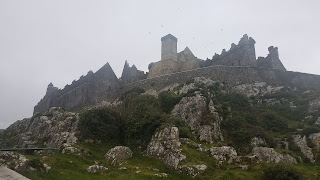February 13, 2019
Wednesday morning the found us up early and out at the Molly Malone Statue waiting for our tour bus to pick us up for a day long tour of some of Ireland's favorite castles.
♪♫♪♫♪
In Dublin's fair city
Where the girls are so pretty
I first set my eyes on sweet Molly Malone
As she wheeled her wheelbarrow
Through the streets broad and narrow
Crying "cockles and mussels, alive, alive, oh"
♫♪♫♪♫
♪♫♪♫♪
In Dublin's fair city
Where the girls are so pretty
I first set my eyes on sweet Molly Malone
As she wheeled her wheelbarrow
Through the streets broad and narrow
Crying "cockles and mussels, alive, alive, oh"
♫♪♫♪♫
We left Dublin at 6:45 a.m. and after an hour and 1/2 on the road stopped for breakfast at the local Circle K Truck Stop. Not what I expected to see in the countryside of Ireland.
Our first stop was at the Rock of Cashel, also known as Cashel of the Kings and St. Patrick's Rock. Cashel is reputed to be the site of the conversion of the King of Munster by St. Patrick in the 5th century.
Mostly a ruin, but part was refurbished and restored in the 1980's.
Many artifacts found on the property are preserved on site.
Tools, Pins, Gold bracelets, dishes and many other artifacts that were found on the ground and are now on display.
The Kitchen ....
And one of the Halls.
The Tapestries are very old, but not original to the site.
Notice the carved faces and figures on the beams from the ceiling. It was a common practice in Medieval times to carve the faces of the Lord of the Manor or other important people in the woodwork. The craftsmen restoring this building in the 1980's used the faces of the volunteers, guides to carve on the beams.
This picturesque complex is one of the most remarkable collections of Celtic art and Mediavel Architecture to be found anywhere in Europe.
The Rock of Cashel was the traditional seat of the kings of Munster for several hundred years prior to the Norman invasion. In 1101, the King of Munster donated his fortress on the Rock to the Church.
Even though it is in ruins, it is so massive and impressive!
The view from this hill top was inspiring, but cold in the wind. The Rock as a fortress was also known for being very cold due to the winds.
Few remnants of the early structures survive: the majority of the current buildings on site date date from the 12th and 13th centuries.
The Cathedral was built between 1235 and 1270.
The round tower is the oldest structure on the site, dating from the 1100s.
I loved the views~
And I especially loved being here with Darryl!
Cormac's Chapel, or the Chapel of the King of Cormac Mac Cairthaigh was begun in 1127 and consecrated in 1134.
The Hall of the Vicor's Choral was built in the 15th century. The Vicor's Choral was made up of laymen who assisted in chanting the cathedral services.
These buildings are so impressive and I can only imagine what it was like to live, work or worship in these grand stone edifices.
The Rock of Cashel, was the seat of the Bishop until the 1700s when the new Bishop decided he couldn't take the cold anymore and moved into a smaller house in the town. Enlarge the picture of the plaque below and it will tell you about St. Patrick's Rock or the Rock of Cashel.
Our next post will have more Castles!

























































No comments:
Post a Comment